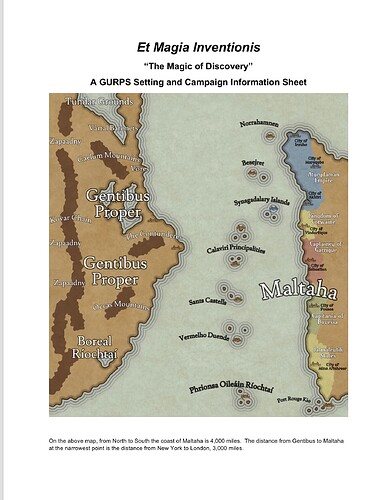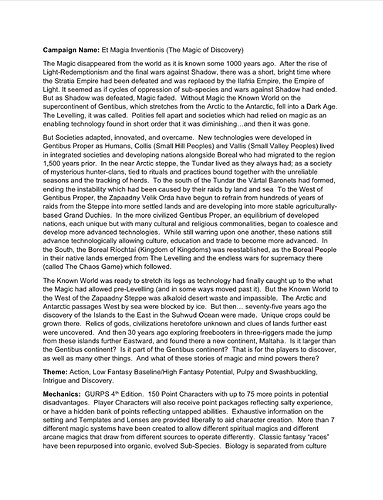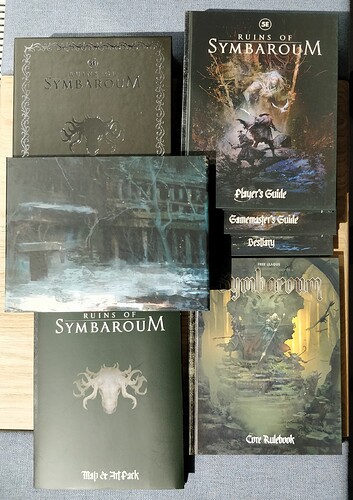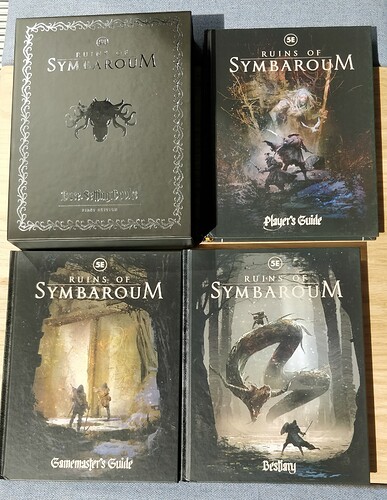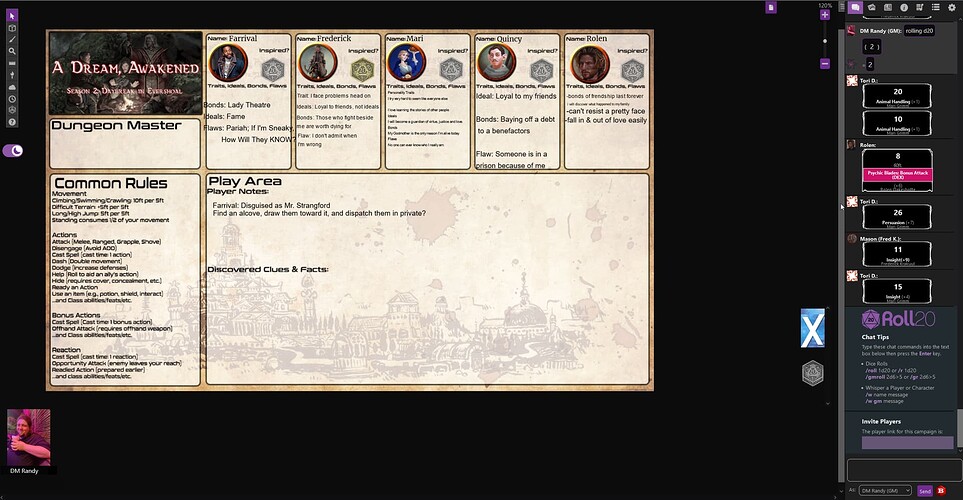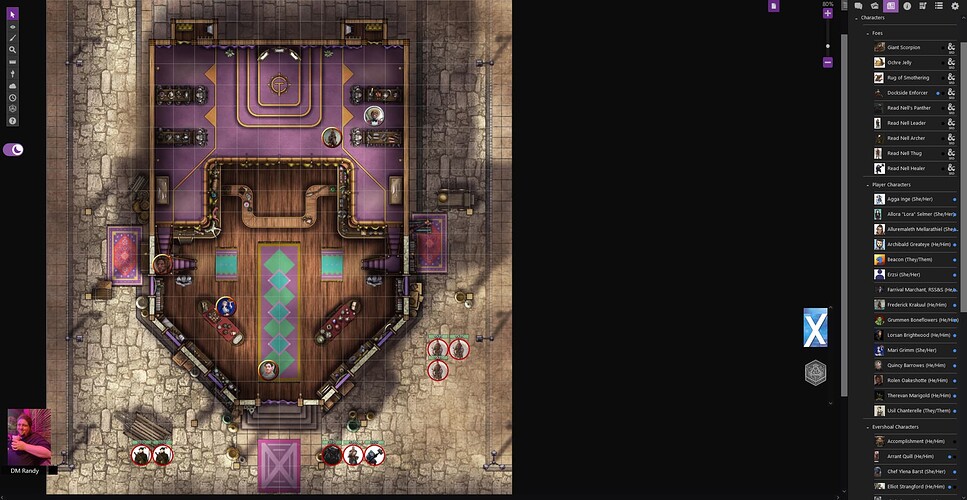That’s pretty crazy, especially the bit decrying multi-culturism. The Tekumel games drew from so many non-western cultures, it’s fairly mind-boggling to read that. Though, I guess some white professor exploiting/profiting off those cultures he doesn’t belong to is probably appropriation on some level, through our modern lense. But that’s a whole different issue, really.
I seriously did a double-take when I first saw this news. I’m not a hardcore fan of Tekumel, but I’m familiar enough with the setting to know that a person holding Nazi/white supremacist views being the creator is just nutty.
Apparently the guy that runs the Tekumel boards (who knew Barker very well) found this particularly shocking because Barker’s dad was a Nazi (in the German-American Bund in the 30s) and Barker hated his dad. The forum guy thought it was possible it was sort of a fucked up prank on Barker’s dad and his dad’s friends, although he doesn’t know and Barker never told him about the book. But like…also it’s a Nazi book that was published by the same people that published the Turner Diaries and was undoubtedly read unironically by thousands of Nazis so even if Barker found that funny (he apparently had a a fucked up sense of humor), I don’t.
Woof meter reads 9999 on this one, damn.
There are some anti-Semites out there (I’ve seen 'em on the Internet) that ONLY hate Jews, and they wonder why other races don’t join them in combating the perfidious puppeteers of, uh, puppetry.
Maybe this is why Barker converted to Islam? Or maybe he got it from particular Muslims he met. (His name was originally Phil, not Mohammed Abdul-Rahman.)
That might’ve worked if Barker hadn’t also been on the advisory committee of Holocaust deniers for years.
Looking around about this, I found the discussion in /osr over at Reddit. In the comments thread there was a pretty interesting take on it
Here’s the wrap up, but it’s not that long, and there’s a short thread that branches from there.
tl;dr I’ve read enough of Serpent’s Walk to know it is definitely M.A.R. Barker, genuine far-right vileness and cringey and embarrassing to boot. Barker’s a complex person, his legacy is at best needing a highly critical re-assessment to salvage anything worthwhile from the muck, and everyone’s gonna have their own takes…but dude held some truly unhinged far-right views and that’s beyond questioning at this point.
Yeah, I think with the Nazis, you really have to go with the Twitter Popehat’s saying, “Even if you’re only fucking a goat ironically…”
All sales proceeds from Witness to the Execution in 2022 will be donated to World Central Kitchen to help their efforts in Ukraine. Additionally, I will match those sales proceeds with an additional donation to Doctors Without Borders (up to $10,000).
TL;DR: You buy the game, I donate twice what I make from it.
I finally picked up Star Trek Adventures by Modiphius. I think this may be the worst actual RPG book I’ve purchased. The RPG system itself is fine. It’s the 2D20 system used by Modiphius for a lot of their licensed products with some Trek flavor that seems to work really well with the property’s mix of conversational encounters and social puzzles mixed with a bit of combat. That’s not the problem. The book’s layout and contents are terrible.
First, it’s white print with dark blue/black backgrounds for most of the text, with sidebar stuff being orange/yellow or pink text on the same blue/black background. Terrible for readability unless you’re in a room with flat, bright, indirect lighting. Second, the whole book is formatted with that LCARS-style graphics to mimic the Next Generation computer displays, which initially seems cool, but just results in a lot of wasted space on the page. It’s really unpleasant for extended reading.
The book is 300+ pages, and the first quarter is fluff, but not good fluff. Instead of a simple history of Starfleet or a straightforward breakdown of the setting, it’s a jumble of excerpts of ship’s logs, article entries, reports, diary notes, communications, wrapped in a fictional welcome packet for a new Starfleet officer. I’m a Trek fan (not hardcore enough to know what LCARS stands for, but enough to know what LCARS is) and most of these snippets were incomprehensible to me without consulting a wiki. There’s a whole section for the Khitomer Accords (people discussing it, institutes learning about it, etc.) that never actually recounts what happened or what any of it really means. It’s nuts and not helpful at all.
I contrast that with the Dune RPG book by Mophidius (also a 2D20 product) and it’s night and day. That book lays out the setting and explains the timeline well enough that I would consider it good to use as a companion for anyone interested in learning about the Dune universe in general. And really, that’s what I expect of any licensed RPG, going back to the old Star Wars game by West End.
I’ve heard enough good things about Star Trek Adventures to stick it out and play, but man, I do not like this book.
Last night, our Armitage Files based Call of Cthulhu campaign was completed after over a year of weekly sessions.
We roamed around Lovecraft Country and beyond. We foiled plots. We killed cultists. We burned buildings, mansions and factories to the ground. We gathered clues. We received letters from another time and dimension. We were attacked and hunted by all kinds of monsters. We were transported to Carcosa. We participated in the raid on Innsmouth during a flashback session. One of our own dug too deep into forbidden knowledge and became ever more unhinged as the months progressed. By the end, the secret came out he had become a serial killer. It led to all kinds of dilemmas and keeping a close eye on him as the finale approached.
Last night was the climax. The world was coming apart at the seams. We had to fight our way to a puzzle to help us close the door on the entity which was pushing its way into the world. It felt so satisfying when each of the clues we had been gathering over the months came together and we each solved one part of the puzzle. High fives all around… until the big bad sent us a message to tell us it was all a game. And he would be back…
I really love the storytelling and the dancing on the edge of impossible situations with impossible odds in CoC. This was so satisfying. The same GM is going to run Masks of Nyarlathotep for us. I can’t wait.
That sounds amazing! That kind of payoff at the end is a real trick to manage, too.
Hi, all. I am starting a GURPS Low-Fantasy campaign here shortly, and thought I would post here to see if anyone would be interested in trying the system. We’re looking for one more player who can do Friday afternoons every other week for 4 hours EST in an online campaign. 150 points + up to 75 in disadvantages. Campaign description attached. PM me if interested. Voice campaign. Looking to start this month. The campaign is a kind of hex crawl; campaign arcs and direction in exploring the unknown is completely in the party’s hands. Two characters per player, assuming that the party likely will split up. Description below. Many templates and lenses to aid character creation. Hopefully we’ll do session zero this week. All other PCs are completed so if you join, my focus will be getting your PCs done. Character backgrounds absolutely and completely will inform the progression and arcs in the campaign. Campaign description below in da Jpegs.
Tales of Xadia by Fandom Tabletop, based on the Netflix cartoon series The Dragon Prince. It’s very much a Western swords and sorcery spin on Avatar: The Airbender. (The showrunner was the head writer on Avatar.) It’s got castles, magic spells, armies, elves, dragons, sword fights, kids running around being heroes, etc. It’s decent YA stuff.
The TTRPG is built on the Cortex system, which is a ruleset that’s been around for a while, primarily used for licensed products like the Serenity, Smallville, and Marvel Heroic games. I guess it was owned by Margaret Weis Productions before Cortex was sold off to Fandom, and they refreshed it with Cortex Prime. (Yes, that’s Fandom, the company that used to be Wikia and owns a ton of fan wikis.) I didn’t have a lot of familiarity with the system, so I picked up a digital copy of Cortex Prime too.
Like many modern TTRPG books, Tales of Xadia comes with a code to redeem a digital copy. In this case, it’s a whole web app experience. There’s a web version of the rules with bookmarks and search fields, etc. You can store characters in the site and there’s even a dice roller. You can also export a pdf of the book. Unfortunately, the character builder is still a WIP, so there isn’t a guided step-by-step way to create your characters, but it’s nice to be able to store and access them online with any device.
A weird omission is that the pdf of the book is very barebones. It doesn’t have bookmarks or a linked table of contents and nothing is hyperlinked in the text. According to the studio, Tales of Xadia is a “digital first experience” so I guess they really want you to use the online app. It’s odd because the Cortex Prime web experience is the same as Tales, but the pdf you get for that book is fully linked and formatted.
The art is gorgeous and fits in nicely with the anime/cartoon. Pages are laid out well. Tons of lore for the world and its people. Lots of diversity and pronoun use, so if that’s a bugaboo for you, this is the wrong property to dive into. Personally, I like it.
The only complaint (which is common for many TTRPs) is that building your own character, instead of using a template, involves a lot of flipping back and forth, consulting rules, and charts, and getting tripped up on a few notes that are important but only mentioned in one spot, and not where you’d expect it. I guess the going back and forth stuff is less of an issue if you’re using the web app, but I’m holding the book in my hands so I’d like to use that.
The Cortex system is fine, if a little odd feeling in practice. Basically, you take a minimum of three dice and roll, pick two dice and total them up to beat a target number set by the Narrator. A third dice you don’t use in the total is the Effect, which is the impact of what you did, and the number rolled on it doesn’t matter, just the die type. The dice come from pools based on choosing one of your three Distinctions (the general “elevator pitch” of your character, like “Arrogant Noble” or “Weary Trailhand”) and one each from other relevant traits like skills, values, powers, assets, etc. Each trait is rated with a die type from d4 to d12.
An example using Tales would be if I want to jump over a stream without falling in (a 12 difficulty) I might roll my d6 in Agility from my Attributes, my d8 for a Distinction of being a haughty Sunfire Elf, a d10 for my Glory because one of my Values is that I want to always excel when an audience is around, and another d6 for having a Specialty as a Dancer. If my rolls were d6 = 3, d6 = 4, d8 = 7, and d10 = 8, I could choose the 7 and 8 to get a total of 15, but that would only leave the d6s to choose as an Effect, so I might want to use the 4 and the 8 for a 13 total (good enough to beat the 12 difficulty) and keep the d10 as the Effect because I really want to dazzle the onlookers with my balletic leap.
Things get more complicated from there thanks to special rules like SFX, Powers, Challenges, etc. but that’s the basic mechanic. For some folks, the amount of picking and choosing dice can be daunting. Like in the example above, maybe it shouldn’t be the d10 for Glory? I could use the d12 for my Mastery because I want to demonstrate how much I learned in my dance classes. Also, there’s some weirdness with Distinctions usually being a d8, which makes me wonder why have three different Distinctions? (In Tales, it’s not even “usually” it’s “always.”) Just have one at d8 and call it a day.
The Cortex Prime system is different from something like Fate, GURPS, or Cypher in that it really is more of a toolkit with a bunch of optional rules. There isn’t even a standard generic character sheet because the only mandatory stat is Distinctions. You might build a game about manners and backhanded compliments at tea parties so you’d only create stats for Distinctions, Relationships, and Etiquette. Unfortunately, this means that using just the Cortex Prime system to create your own setting and characters can be a ton of work depending on how mechanically deep you want the game to be. Thankfully, Tales of Xadia offers a fully-fledged world with the system already pared down to where it needs to be for the setting.
Yeah, Cortex has always been primarily deployed in licensed RPGs like Tales of Xadia over the years, so the Cortex Prime project was an attempt to present the core framework in a way that was easier for other people to build on without having to strip the license layer away first. But I don’t think it was ever designed to be something you can just run out of the box with no work to customize it, whether your own or done for their licensed stuff.
I think that’s true for all “genre-less” systems like Hero, GURPS, Fate, Savage Worlds, Cypher, etc. I think Cortex Prime is really a different beast in that everything is so modular that even deciding what parts should be in your game is a whole process.
I’m a bit disappointed that the web app doesn’t have a way to build a formatted character sheet by assembling the chunks you want. Like a drag and drop interface. As it currently stands, if you’re building your own setting and not using one of their pre-made examples, you’re going to have to break out Excel or have some graphic design chops if you want a decent looking sheet.
Edit: Also, I’m amazed that there was a Smallville TTRPG.
My own Free League Kickstarter delivery happened today. Ruins of Symbaroum is here!
I picked it up on the way to work today and it’s up to the usual Free League quality standards.
I added the standard Symbaroum core rules (because they look interesting in their own right) to the pack containing all the 5E books, a map pack, art prints and starter adventure. It’s a weighty package. Lugging it to work has given me some exercise. 😰
So, now I just need to do some light reading and find players to play some 5E Symbaroum.
All my whinging today about D&D and online play aside, I really wanted to share about my recent experience from this weekend, with a gigantic lore dump of exposition about the campaign, first. Y’all were forewarned :) I’ll, uh, toss a line break in when I get to my actual session, hahaha
Origins of the Big D&D Campaign
So, I’ve talked quite a bit before about Raleigh Tabletop RPGs’ Semi-Organized Play campaign format – multiple GMs collaboratively build a setting/work out a plot/write sessions within that structure, then run 2-4 tables simultaneously each session that players sign up for based on which ones sound interesting to their characters (so a big group of PCs get mixed and matched every week), all to tell a short-length story over the course of 3 IRL months, then wrap it up with a big cool finale, and hopefully bring that setting back the next year if it was well-liked.
For years, a defining trait of the program was that we didn’t really have a traditional d20-based fantasy game. I mean, first and foremost, Pathfinder Society and D&D Adventurer’s League kinda fill that niche already (albeit without structured “season” arcs and the metagame elements our SOPs include like building up team bases or befriending longterm NPC allies). But also, RTR is pretty heavily on the “indie RPGs and horror games” side of the TTRPG spectrum, so, our initial forays were in systems like Chronicles of Darkness and Call of Cthulhu, and has variously included options like Fate, Mouse Guard, and Mutants & Masterminds over the years.
But, hey, it turns out, if you’re the first google result for “raleigh dnd group” or whatever, newcomers pouring into the hobby via things like Critical Role, The Adventure Zone, Stranger Things, etc., want some D&D, man. So, a couple of years ago, leadership pulled together a team to develop a D&D 5E SOP.
That was spearheaded by my good buddy Justin, who I’ve described before as my favorite GM ever, and certainly the most talented at the craft I’ve ever played with directly. He was showrunner for one of our most popular SOPs and a cornerstone GM for a few others besides over the years; definitely a pro at that development process.
Then, right in the middle of the planning stages, Covid hit, and the team splintered. Justin rebuilt it with one of the remaining GMs, backing away to more of an advisory role due to some health issues. Eventually, he had to step away from RTR entirely, but not before he’d helped build out a really compelling, cool “smalltown level 1” type setting for the players to run around in for Season 1, which wound up running with a small team of GMs last spring. They had a ton of interest – way more than the diminished team could really fulfill with just 2-3 tables of 5 players a week – including a lot of new people, a couple of whom have stuck around and become good community members, and in general, I think it was very successful. People loved the worldbuilding and cool high fantasy shenanigans, and the fact that it was a little bit of a crunchier system than what we usually run.
In Which Mando Joins Up And Doesn’t Know What He’s Gotten Himself Into
For various reasons, I found myself with an opening in my calendar this year, and heard that the team for that game, called A Dream, Awakened, was kinda struggling with another member having to drop out due to a newborn, so I offered my services as a mercenary drop-in DM in late January. The season was set to start in early April, so I figured, hey, they’ve got most of it done by now, but I can run some tables they don’t have a warm body to sit in for to help fulfill demand. The showrunner was very glad for the offer and pulled me in right away.
And, uh, oh buddy. Seems like since last year’s season, not a ton of work had happened. In pursuing a lingering mystery from the end of last season, the PCs were set to strike out for the capital city, leaving behind their small town lives, so this was gonna be a whole new setting, and apart from a couple-page doc (of which 25% was just a big, unlabeled map, lol), there was basically nothing in their shared Google Drive about the new city, Evershoal. And an extremely vague multi-season outline of a possible story, with no real details about the driving conflict for Season 2. From the sound of it, the showrunner there preferred to run a very loose ship, trusting each DM to run a good session on any given week without a ton of central guidance, which is pretty unusual within the SOP program.
Now, that – obviously – made me nervous. Worse, I was a total newcomer here in more ways than one. I didn’t play last year – I preferred to leave the limited RSVP slots to newcomers. I didn’t run last year, either, obviously. So, I had very little idea what had happened that might influence things to come in S2. One of the really nice things about the SOP program is that the campaign can acknowledge individual character accomplishments and relationships in ways that, say, Adventurer’s League really can’t. Not knowing any of these characters or what they’d been up to, I was afraid I wouldn’t be able to make the world feel responsive to them and when I checked the team’s “PC Information” spreadsheet, like 60-70% of the fields in it for things like “backstory connections” and “character background” were left blank. Oh buddy.
Doing Way Too Much Work No One Else Bothered With/Wanted
So, in a fit of moderate anxiety combined with avoiding really unpleasant work commitments I didn’t want to think about, I started writing. Like, a LOT. And I’d keep checking in with the other guys on the team – hey, does our big bad have any lieutenants yet? any henchmen he’s using to make his plans work? what about the secret society of watchdogs that the players are being recruited by – do we have any established NPCs for them? a home base they operate from? – but generally speaking, the answer was always, “Nope, we haven’t thought about that.”
Now, thankfully, we had a couple of productive webconference meetings in February and March to flesh out the season storyline a little more, and I got the Showrunner to write us a nice little doc on “what would happen if the PCs never interfered” to kinda give us the 10,000 foot view of the villains’ plans. That revealed some really cool potential political intrigues going on here, which is great for “the big fantasy city” season of our D&D game. And the ideas other DMs pitched for possible sessions to fit into that milieu were really cool and flavorful, and we hashed out some fun connections between them to tie things together more, creating a more cohesive whole to work from.
But, still, I wound up writing out more or less the entire setting doc of NPCs, enemies, locations, and organizations. Checked in with Season 1 players to help tie in elements where I could – the temple of Moradin one armorer had trained in in the big city, the criminal gang that had betrayed another one when he worked as a fence, the theater company that had kicked another out for being a self-centered jerk. Even went so far as to record a video RP guide for some of the major NPCs, so we could all be on the same page when portraying them to players each week.
And then, ugh, there’s 5E GMing. I ran Pathfinder 1E for years in one-shots and a campaign alike. I had a few abortive attempts at starting 3E and 4E games many years ago when I was much younger, but nothing that lasted more than a session or two. And it’s been years since I was running PF. Mind, I play in a 5E campaign, and have been in a few more besides. How hard could it be? Cue a few weeks of consuming a fuckload of 5E-focused Youtube content. Jesus lord are there a lot of insufferable-ass dudes yelling about 5E on the internet, haha.
Then, hey, we’re still online in RTR’s public games, so, hell, gotta figure out 5E via Roll20. I tend to run very theater-of-the-mind-y games, but wanting to engage with the system as it intends, I knew I wanted to have some fights in my sessions, and wanted to use stuff like grid-maps to let the more munchkin-y players get all their neato ruler-requiring jollies. God, crafting a 5E NPC/monster is so much more draining than Fate or PbtA. Nevermind that all of my 5E investment was in D&D Beyond (no more room for physical books in my house, lol), so I was stuck relying on basic OGL Compendium content within roll20 unless I wanted to figure out how to dump in monster stats from the 5E books I “own” in Beyond. And of course bugging people to get me character art for tokens, setting up a good safety tools deck, making a nice little playsheet for scenes without combat. . . I’m actually pretty proud of how this looked!
The Game Itself
First, some gratuitous VTT porn.
The Inspired token is actually a Roll20 “deck” so the cards can be flipped from side to side to reflect who’s got Inspiration. Players write in their own Traits in their card areas; the rest of the text is largely baked in.
Hello yes I totally ripped off Gilmore’s from CritRole C1. Also check out them snazzy modified Compendium baddies + the entries for every active player in the campaign!
lol even more NPCs and location handouts
Anyway, I ran my first session last Friday night for five players – 3 Rogues and 2 Warlocks, one of whom acts like a Rogue (the other’s a magical girl, yay). Three were returning from last year – Mari the magical girl, Quincy the failed fence, and Farrival the disgraced actor – and two were newbies to the campaign and the group as a whole – Rolen, the tragically orphaned former noble, and Frederick, the city-guard-turned-smalltown-PI who’d come back into town to solve the murder of his former mentor.
The premise was pretty straightforward. The Harpies (totally not The Harpers), the secret society of brave souls that safeguards the micronation of Hallea against threats domestic and intraplanar, were not entirely prepared for like 16 randos from the middle of nowhere to show up on their doorstep looking to help investigate the nefarious machinations of Elliot Staten, preeminent Evershoal businessman. As in, their safehouse, the Celaeno House in the city’s dark and gritty Underhang district, was completely out of food stores and, more importantly, coffee.
Luckily, there was a mostly reputable merchant/smuggler/fence down by the docks who’d always cut them good deals in the past, but he’d mysteriously vanished a few days ago, so, two birds with one stone, they sent the PCs out to restock supplies and find the missing merchant.
They stumbled and bumbled into an ongoing gang turf war down by the docks, as outside interests had paid off enforcers to centralize control of the criminal underworld there for as-of-yet unknown reasons, and Elliot Strangford, the Harpies’ favored shopkeep, was holding out against the violent advances of the infamous Read Nell gang, run by equally infamously illiterate ex-librarian-turned-gangster Nell.
The party managed to break into his fortified magic shop despite Rolen faceplanting onto the street outside from a second-story window, snuck past his protective enchantments, and convinced him they were on his side, then sent out Farrival the actor dressed up as Strangford to lure the Read Nells into a nearby alleyway for an ambush. Well, until he rolled double-nat-1’s on his Performance check and failed to convince about half the gang he was the real article (mind, between Proficiency, Expertise, and a Disguise Self spell, it was still pretty effective even with the 1s), so, cue a two-pronged fight as half the thugs walked into the alleyway trap and the other half started axing down Strangford’s front door.
It was pretty thrilling and we had some real close calls – Quincy nearly got his head bit off by Nell’s beloved pet panther Gettem and had to action-roll off the side of a roof to get away safely, and Frederick was slinging crossbow bolts and insults like Strangford’s life depended on it to keep the gang distracted. The party managed to eventually down most of the gang members and even the big scary cat, but Mari the magical girl felt bad and magically healed Gettem back to consciousness, then befriended her with the help of her own familiar, Orion the pseuodragon and a rubber bouncy ball.
Nell, recognizing his number was up with most of his gang dead or scattered and his beloved kitty playing with the enemy, gave up and helped them get the drop on the nasty enforcer pulling the strings on the docks. She coughed up the name Staten before begging to be allowed to skip town before she got off’ed for giving up her secret boss.
The party chased down a few personal leads – Rolen’s got the name of another noble family mixed up in courtly intrigues like the ones that got his parents killed (???); Frederick’s got the name of a dirty Slatebearer (city guard) who was bragging about covering up his mentor’s death; Farrival’s got a new best friend/frenemy/crush(???) in Strangford; and Mari’s now a serving girl at a local tavern run by Linthel Dannisin, an elf who bears an alarming resemblance to Eeyore, so she can pick up rumors – and then we wrapped up.
The Importance of Player Feedback
All in all, things went really well, apart from one thing. Rolen’s player Jon made a couple of remarks in the vein of “I’m going to do everything I can to protect Mari, because she’s so pretty I just can’t help myself!” despite the fact that the healer-Warlock was probably the most combat-capable person at the table with her 17 AC, 40 HP, and 2 1d10+4 eldritch blasts a round. Apparently while I was away during a break, he kept pushing that point OOC, too, in a way that felt a little creepy.
In the SOP program, we always do a post-game survey with our players to collect feedback and shape the rest of the season, and I’m honestly super proud that, in addition to Mari’s (female) player, two of the other guys at the table also noted in their feedback that Rolen’s behavior made them uncomfortable and they’d like us to talk to that player.
Luckily, dude was super receptive to feedback, felt absolutely horrible about how he’d come across, and agreed to tweak his character and behavior alike going forward to, you know, treat female characters like people instead of fainting daisies, and I think we’re gonna be all good there.
Players have been following up on leads all weekend long in our group Discord server, and the other DMs are jumping in with their own clues and foreshadowing for future sessions they’re gonna run now – everyone’s energy levels are super high! – and it’s feeling like all that anxiety-inducing work I did to try to get things in a better place might have actually paid off. People loved the NPCs and new setting and weren’t sad at all to have left their smalltown origins from Season 1 behind (though they can always write letters home for Inspiration points, if they want).
So, to brag a little, gonna drop some of the feedback that really, really made my night.
And the kicker at the very end:

I’m on the hook for a couple more sessions this season – a classic dinner party with the nobility drenched in intrigues and plotting, and a daring high-stakes heist mission aboard the huge steampunk cable cars that carry people and goods up the 1,500 ft cliffs looming over the undercity – and gotta say I’m really, really excited to see what comes next :D
I’m interested in reading some impressions after you delve into it a bit. The combat in Symbaroum is great—fast and brutal, true to the setting, with the bonus of keeping most adventures around two hours or so—but it’s certainly a bit bare in other respects, mechanically speaking (it’s a very combat-centric game, so that’s not surprising).
Of course, the setting is the star here, so it makes sense they’d want to get it to a large audience by adapting it to 5e: ancient magic, a seemingly evil forest, remnants of a lost civilization, an abandoned homeland, a new frontier kingdom clinging to survival, various political factions vying for influence. There’s a lot of story hooks and it’s particularly cool to see the campaign modules tease them out.

